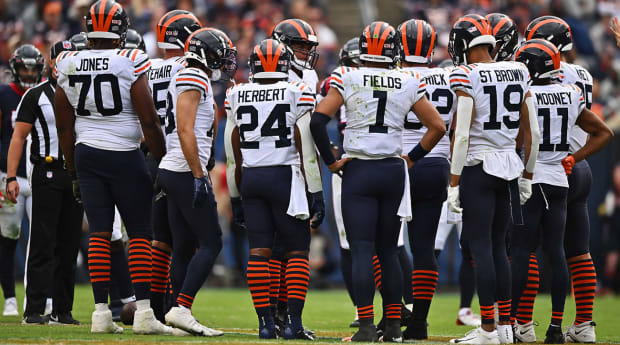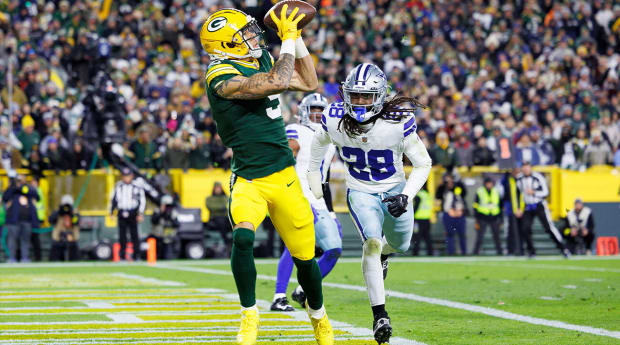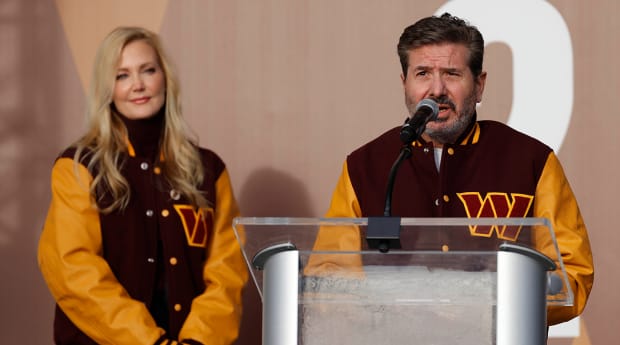The Bears are quite a study in the business of football. They have a 2022 payroll of roughly two-thirds of the NFL salary cap. They are playing with more of a postgraduate team than a professional team, with the vast majority of their players working on fixed and reasonable first contracts. The lack of highly paid players on Chicago’s roster is stark.
The 2022 salary cap is $208 million; the Bears have a payroll of roughly $140 million. To put that in perspective, the Bears’ payroll is:
• $18 million below the league’s second-lowest spending team, the Falcons.
• $85 million below the league-average payroll of $225 million.
• $150 million below the league’s highest-spending team, the Rams.
And that sum includes paying the bulk of the salaries of Robert Quinn ($12.2 million) and Roquan Smith ($9.16 million), two of their three highest-paid players, now playing for the Eagles and Ravens, respectively.

Jamie Sabau/USA TODAY Sports
By now you are probably asking this question: “But Andrew, aren’t there minimum spending requirements in the NFL?” Well, yes, but if you have followed my coverage of the collective bargaining agreement, you know that I believe those spending requirements to be deficient from the players’ side. The minimum thresholds calculate teams’ spending over three or four years—depending on the CBA time frame—rather than every year. Were there annual spending minimums in the NFL, there is no way the Bears would be compliant this year in spending roughly 67% of the cap. They are “coasting” this year, certainly planning on upticks in future years to meet the minimum thresholds (it would be hard to spend less). And they are more than happy to pay Quinn and Smith as part of the trade conditions; they have to pay someone!
In MLB terms—where there is no cap and no minimum spending threshold—the Bears are “accumulating prospects.” In NBA terms, the Bears remind me of the “Trust the Process” 76ers from a few years ago: sacrificing present results for the sake of future success. I was a neighbor of the architect of those Sixers teams, Sam Hinkie, and I remember him telling me, “Andrew, there’s no reward in mediocrity.”
Even at 3–7, the Bears have a scintillating young quarterback in Justin Fields and are getting good value from their roster with the league’s lowest payroll.
The Packer Way frustrates many

Jeff Hanisch/USA TODAY Sports
The Packers had a stirring win Sunday over the Cowboys at Lambeau Field, showing signs of life they had not shown in many weeks. The team for which I worked for 10 years seemed at a crossroads and, for one game at least, showed why they are still the Packers, no matter the record.
The team, of course, was crickets at the trade deadline, frustrating scores of fans who see obvious needs for improvement, especially at wide receiver. I can picture the Packers’ discussion of making those moves. They would be saying no, as acquiring such a player would potentially stunt the development of rookie receivers Christian Watson, Romeo Doubs and Samori Toure.
When people ask me, as so many do, about the Packers’ lack of aggression in free agency and trades, my answer is always the same: “What part of ‘Packers’ do you not understand?” The front office has been operating a certain way for decades; this philosophy is not new and not going to change now. The Packers are a “draft and develop” team, their chosen formula that has brought sustained success, albeit with two Super Bowls in the Brett Favre/Aaron Rodgers eras.
The Packers do step out into free agency on occasion, as I know so well from my monthlong pursuit of free agent Charles Woodson in 2006. And, in fairness, they did reportedly make an offer for Chase Claypool at the deadline, just not a high enough one. But these forays are exceptions to the rule of draft and develop. Indeed, we had an adage in Green Bay about free agency: “Free agency is the price you pay for not drafting well.”
Watch the Packers with fuboTV. Start your free trial today.
I lived that world for 10 years; it is no different now. The current Packers general manager, Brian Gutekunst, is a disciple of former general manager Ted Thompson, who valued the draft above all else. The draft drives team-building in Green Bay, in the past and present.
I will have columns ahead on what I believe will happen with Rodgers and the Packers after this season, but we are now at an inflection point in that relationship. The time is soon coming, though, when Green Bay fans will experience what every other team has in the last 30 years: not being led by a quarterback heading to the Pro Football Hall of Fame.
I know some are already ready to move to the future, but savor this waning time with Rodgers.
More drama in the DMV

Geoff Burke/USA TODAY Sports
The hits keep coming for Commander Dan, now facing a consumer protection lawsuit from the Washington, D.C., attorney general alleging Commanders owner Dan Snyder, the NFL and commissioner Roger Goodell fraudulently lied to the citizens of D.C. I don’t think there is much to the suit.
In the bigger picture, though, the new lawsuit has more embarrassing details of Snyder’s wannabe “Wolf of Wall Street”–style of leadership, mistreatment of female employees and generally awful behavior. My sense is this suit details what would have been revealed in the report from investigator Beth Wilkinson, if Snyder and the NFL had let it see the light of day. If the league had simply released the Wilkinson report, or if whoever leaked Jon Gruden’s emails had not done so, there probably would not have been months of drama around Snyder.
And, oh by the way, Snyder is supposedly/purportedly/maybe going to sell the team; to which I say: I’ll believe it when I see it.
Snyder retained Bank of America (BofA) to explore “potential transactions.” While that
could mean a sale of the majority of the team, or even the entire asset, it could also merely be exploratory. BofA has long worked with the NFL and several NFL owners on debt financing. Perhaps Snyder is merely seeing what number he can attract (estimates have forecast as much as $7 billion or more) to then use that splashy number for stadium financing, also with BofA. As we know, no politician—whether from D.C., Maryland or Virginia—has an appetite for helping Snyder with public funding.
Or Snyder may just be looking to sell off a part of the team, up to 49%, while retaining his cherished identity as team owner. He would gain both liquidity and the prospect of a much more popular minority owner (who may also help the league diversify its overall ownership ranks). Even if it is a total sale, there is good news and bad news: The good news is there will eventually be a new owner of the Commanders; the bad news is it will likely come in stages, and the process may take a year or longer.
As I have repeatedly said, the NFL and its ownership is not going to vote out Snyder, no matter what Jim Irsay said. They don’t want the precedent or to be tied up in court for a decade. But the more effective strategy, as I outlined in a previous column, of “Sarvering” him—having the commissioner, other owners, sponsors and perhaps even coaches and players get him to take the money and run—may be occurring.
To all my friends and family in the Washington area who ask me about this every week: Yes, this is hopeful news for your wish for an ownership transfer, but, as all things, we will see. And, of course, there will be lawyers.







